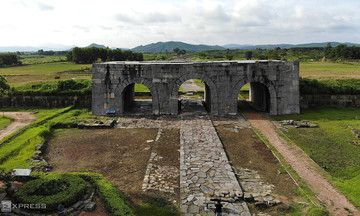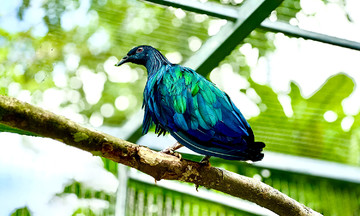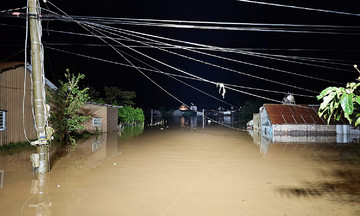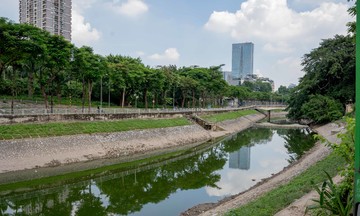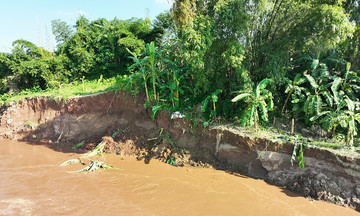The rectangular tomb, with a pointed top resembling a roof, is constructed of brick, sand, and molasses. After nearly 200 years, the plaster has peeled, and moss has grown over it. Unlike many ancient tombs shaped like crouching elephants or tortoise shells, such as the tomb of Ta Quan Le Van Duyet, General Buu’s tomb resembles the tomb of King Gia Long in Hue.
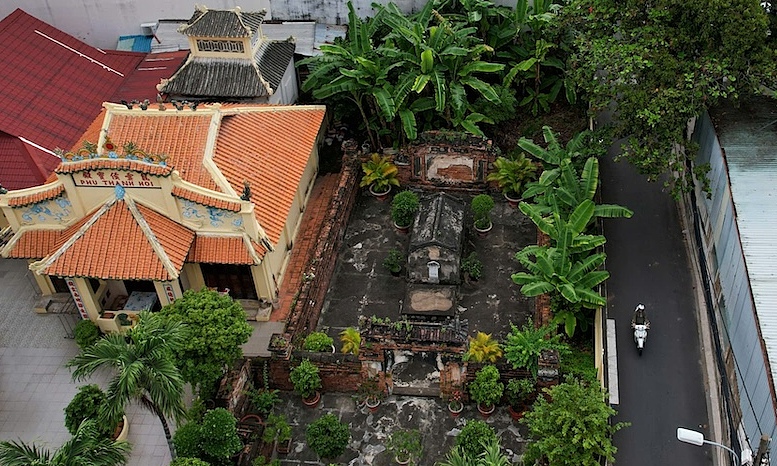 |
The tomb and temple within the Long Van Hau Truong Tan Buu mausoleum on Nguyen Thi Huynh Street, about 3 km from Tan Son Nhat Airport. Photo: Dinh Van |
The tomb and temple within the Long Van Hau Truong Tan Buu mausoleum on Nguyen Thi Huynh Street, about 3 km from Tan Son Nhat Airport. Photo: Dinh Van
In front of the tomb are a memorial tablet and altar. The tomb is surrounded by a laterite wall over one meter high, now cracked and deteriorated. The tomb is located within a 2,300 m2 mausoleum next to the Truong Tan Buu temple, which was recognized as a national architectural and artistic relic in late 2004.
The current caretaker is 64-year-old Le Cong Minh. In 1941, Nguyen Van Dat, head of the Phu Thanh Association in Phu Nhuan, built a temple next to the tomb. Since then, Minh's grandfather, parents, and now Minh himself, have continued to care for the site.
Every month, Minh cleans the area and burns incense on the 1st and 15th days of the lunar month. On the anniversary of General Buu's birth and death, the family holds a memorial service. Inside the temple are a memorial tablet, a statue of a white horse, 18 weapons, and an official's hat displayed in a glass case. A horizontal board inscribed with "Thien Nam Ban Dien" in Chinese characters, praising the general’s merits, hangs on the wall.
Truong Tan Buu was born in 1752 in Giong Trom (Ben Tre), the third of seven children. From a young age, he was tall and skilled in martial arts, having grown up in a forest teeming with wild animals.
At the age of 36, he met Nguyen Phuc Anh (later King Gia Long), who was being pursued by the Tay Son rebels in the Mekong Delta. He offered his service and was quickly appointed Commissioner of Military Affairs at Vam Nao (the confluence of the Tien and Hau rivers). After many victories, he was granted the title of Long Van Hau.
 |
The rectangular tomb of Truong Tan Buu, with a pointed top resembling a roof, is covered in moss. Photo: Dinh Van |
The rectangular tomb of Truong Tan Buu, with a pointed top resembling a roof, is covered in moss. Photo: Dinh Van
In 1790, he was promoted to Hau Quan (Rear Guard) and then Tien Quan (Vanguard) – a crucial mobile force. Following several triumphs in Binh Dinh, he was promoted to Tien Quan Deputy General, and then Commander.
Historical records show Truong Tan Buu repeatedly defeated pirates from the north. In 1802, he captured 70 pirates in the Van Don – Kinh Mon region (present-day Quang Ninh and Hai Duong). In 1806, he defeated over 30 pirate ships in Quang Yen. In 1808, he achieved two more major victories, killing and capturing over 70 pirates.
Throughout his career, he participated in 36 battles, suppressing rebellions and securing the border. He was then promoted to Trung Quan Deputy General, commanding one of the five main armies of the court.
In 11/1810, when Governor Nguyen Van Nhon of Gia Dinh Citadel led troops to Nam Vang (Cambodia), General Buu was appointed Acting Governor for two years. In 1812, Ta Quan Le Van Duyet replaced him, and General Buu became Deputy Governor, managing the Dong Nai and Binh Thuan regions. The people called them "General Duyet, Deputy General Luong".
After six years, he was summoned back to the capital to oversee Trung Quan (Central Army). When Gia Long passed away in 1820, the succeeding King Minh Mang continued to value him, granting him a gold seal. The following year, he returned to Gia Dinh as Deputy Governor when Le Van Duyet executed Huynh Cong Ly. For his many contributions, he was promoted to the highest rank, Chanh Nhat Pham, and was granted materials to build an ancestral shrine in his hometown.
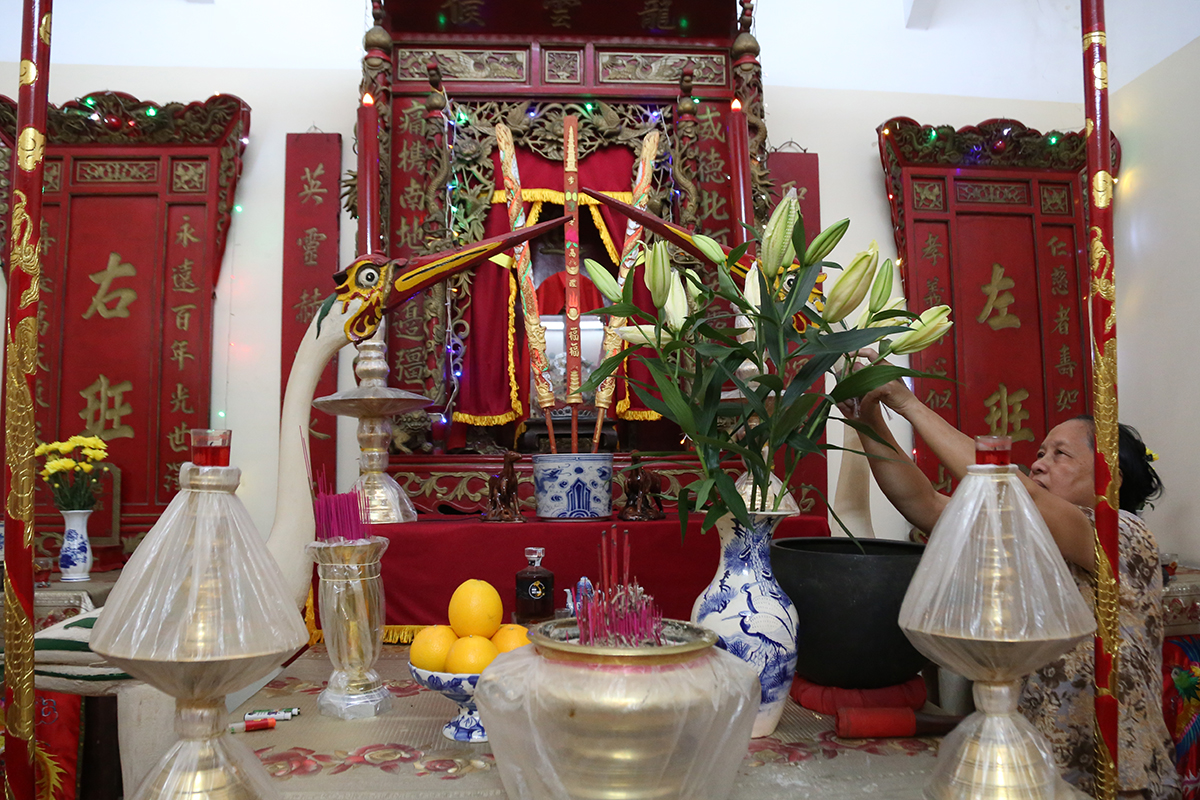 |
The family of Le Cong Minh takes care of the incense burning and ceremonies at the temple next to the tomb of Long Van Hau Truong Tan Buu. Photo: Dinh Van |
The family of Le Cong Minh takes care of the incense burning and ceremonies at the temple next to the tomb of Long Van Hau Truong Tan Buu. Photo: Dinh Van
In addition to his military achievements, he also contributed to water management. When Le Van Duyet, overseeing the Vinh Te Canal excavation, fell ill, General Buu took over command. The three generals under his command were Nguyen Van Thoai (Thoai Ngoc Hau), Nguyen Van Tuyen, and Nguyen Van Ton. Upon the project’s completion, he was rewarded with silk and money.
The Vinh Te Canal became the most important irrigation and transportation project in the Mekong Delta during the feudal period.
After nearly 40 years of serving the king, he retired due to illness. Two years later, he passed away at the age of 76. King Minh Mang entrusted Le Van Duyet with the burial arrangements, providing 2,000 quan and five pieces of brocade for the tomb's construction.
He had four children (three sons and one daughter), but they all died young. In historical records, he is mentioned as one of the "Five Tiger Generals" of the Gia Long dynasty, along with Le Van Duyet, Nguyen Van Nhon, Nguyen Van Truong, and Nguyen Huynh Duc. They served as Governors of Bac Thanh and Gia Dinh Citadel, holding power on behalf of the king to govern vast territories.
Dinh Van




